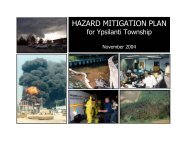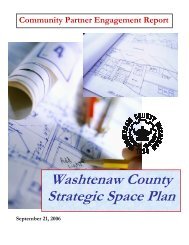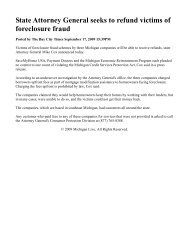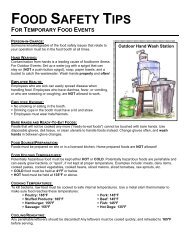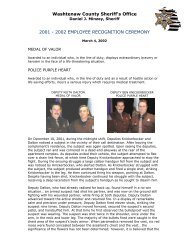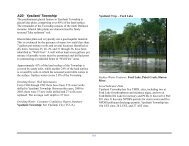Water Protection Activities in Washtenaw County
Water Protection Activities in Washtenaw County
Water Protection Activities in Washtenaw County
Create successful ePaper yourself
Turn your PDF publications into a flip-book with our unique Google optimized e-Paper software.
Executive Summary<br />
Introduction<br />
The <strong>in</strong>tent of the <strong>Washtenaw</strong> <strong>County</strong> <strong>Water</strong> <strong>Protection</strong><br />
<strong>Activities</strong> <strong>in</strong> <strong>Washtenaw</strong> <strong>County</strong> Report (WPA) is to provide a<br />
s<strong>in</strong>gle source of <strong>in</strong>formation for <strong>in</strong>dividuals <strong>in</strong>terested <strong>in</strong><br />
potential sources of contam<strong>in</strong>ation to groundwater and surface<br />
water <strong>in</strong> the <strong>County</strong>, and to highlight the protection activities<br />
designed to address those concerns. The report further<br />
identifies sources of dr<strong>in</strong>k<strong>in</strong>g water and the underly<strong>in</strong>g geology<br />
that affects those sources. The report is the product of<br />
collaboration between the <strong>Washtenaw</strong> <strong>County</strong> Dra<strong>in</strong><br />
Commissioner’s Office and the Plann<strong>in</strong>g and Environment<br />
Department. The protective actions identified <strong>in</strong> the report<br />
feature programs adm<strong>in</strong>istered or most frequently referenced<br />
by the two offices. It is recognized this is not an exhaustive<br />
list<strong>in</strong>g of all of the actions be<strong>in</strong>g taken to protect, preserve or<br />
restore water quality <strong>in</strong> the <strong>County</strong>.<br />
Groundwater<br />
Historic <strong>in</strong>formation regard<strong>in</strong>g the quantity and quality of<br />
groundwater was gathered primarily from databases ma<strong>in</strong>ta<strong>in</strong>ed<br />
by <strong>Washtenaw</strong> <strong>County</strong> Plann<strong>in</strong>g and Environment (WCPE),<br />
and the Michigan Department of Environmental Quality<br />
(MDEQ). Those records were utilized to determ<strong>in</strong>e that<br />
generally the groundwater <strong>in</strong> the area is plentiful, of a high<br />
quality, and serves as the source of dr<strong>in</strong>k<strong>in</strong>g water for over<br />
50% of the residents and bus<strong>in</strong>esses <strong>in</strong> the <strong>County</strong>. The<br />
programs <strong>in</strong> place to address groundwater protection have been<br />
highly successful. However, there are still challenges to the<br />
<strong>County</strong>’s groundwater, <strong>in</strong>clud<strong>in</strong>g:<br />
v<br />
Arsenic<br />
Naturally occurr<strong>in</strong>g arsenic exceed<strong>in</strong>g dr<strong>in</strong>k<strong>in</strong>g water standards<br />
has been detected <strong>in</strong> approximately 10% of the <strong>in</strong>dividual<br />
dr<strong>in</strong>k<strong>in</strong>g water wells tested <strong>in</strong> the <strong>County</strong>. To address this<br />
issue, WCPE now requires test<strong>in</strong>g of all new wells,<br />
replacement wells, and residential wells at time of property<br />
transfer. Treatment or replacement of the wells are options to<br />
address this issue.<br />
Quantity<br />
Individuals <strong>in</strong> some parts of southeast <strong>Washtenaw</strong> <strong>County</strong> have<br />
had difficulty <strong>in</strong> obta<strong>in</strong><strong>in</strong>g a reliable, high-quality dr<strong>in</strong>k<strong>in</strong>g<br />
water well. The comb<strong>in</strong>ation of hydrogen sulfide and lowyield<strong>in</strong>g<br />
upper aquifer formations have been particularly<br />
challeng<strong>in</strong>g <strong>in</strong> Augusta Township. To address this need,<br />
municipal water was extended to approximately 30 miles of the<br />
Township <strong>in</strong> the mid 1990’s. Well test<strong>in</strong>g occurs <strong>in</strong> the<br />
southeast portion of the <strong>County</strong> and <strong>in</strong> ten other isolated<br />
locations throughout the <strong>County</strong> to assure adequate water can<br />
be obta<strong>in</strong>ed before issu<strong>in</strong>g a construction permit for new<br />
homes. Additional storage is often <strong>in</strong>stalled <strong>in</strong> homes to<br />
compensate for low produc<strong>in</strong>g wells.<br />
1,4-dioxane<br />
The groundwater <strong>in</strong> areas of Scio Township and the City of<br />
Ann Arbor is contam<strong>in</strong>ated with 1,4-dioxane, a suspected<br />
carc<strong>in</strong>ogen. The contam<strong>in</strong>ation plume, which is currently<br />
estimated as three miles long and one mile wide, is the result of<br />
manufactur<strong>in</strong>g practices by Gelman Sciences (now Pall Life<br />
Sciences) from 1968 - 1986. The risks, methods and degree of<br />
remediation of the contam<strong>in</strong>ation have sparked scientific<br />
debate, public activism, government resolutions, and lawsuits.<br />
Due to the nature of the contam<strong>in</strong>ant and the complex geology<br />
<strong>in</strong> the area, the problem will likely cont<strong>in</strong>ue for years to come.



